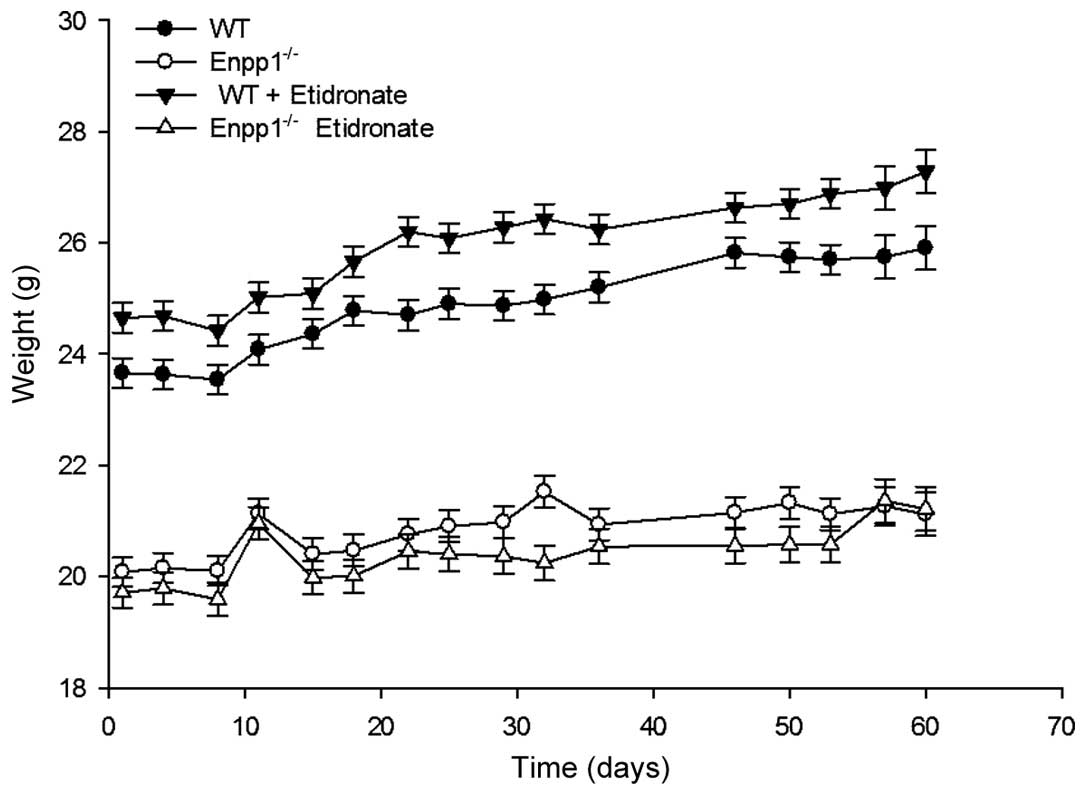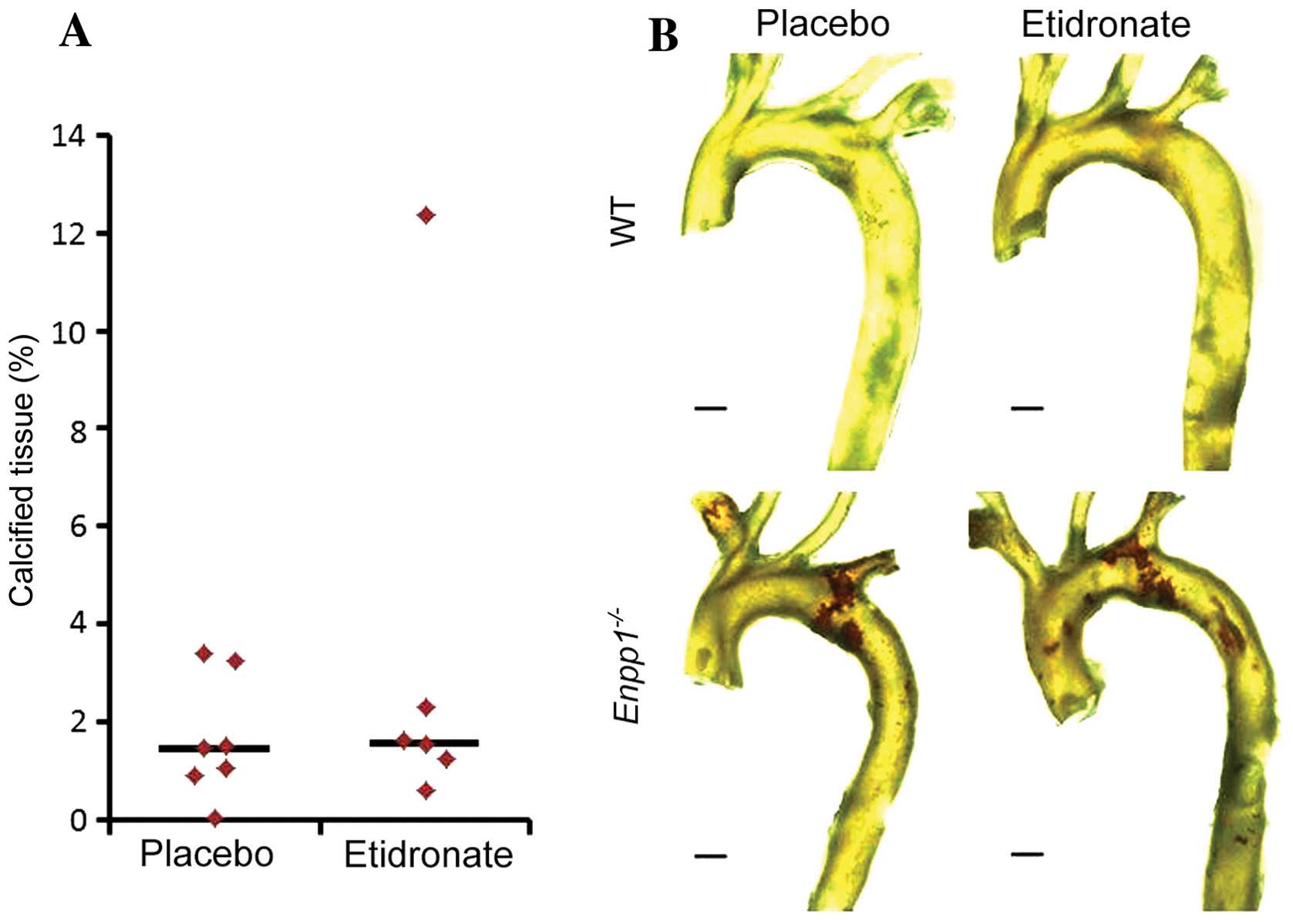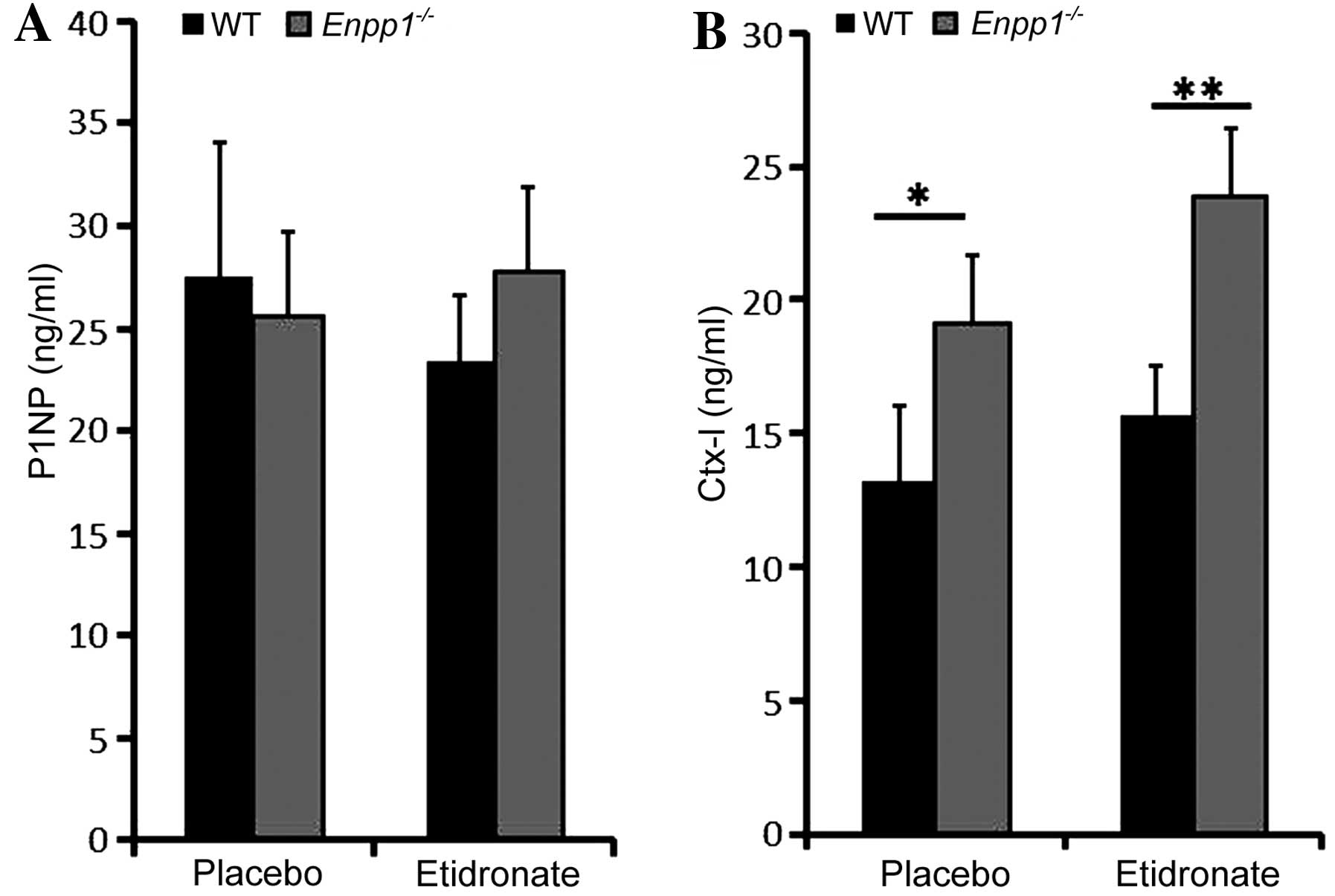|
1
|
Rutsch F, Ruf N, Vaingankar S, Toliat MR,
Suk A, Höhne W, Schauer G, Lehmann M, Roscioli T, Schnabel D, et
al: Mutations in ENPP1 are associated with ‘idiopathic’ infantile
arterial calcification. Nat Genet. 34:379–381. 2003. View Article : Google Scholar : PubMed/NCBI
|
|
2
|
Rutsch F, Vaingankar S, Johnson K,
Goldfine I, Maddux B, Schauerte P, Kalhoff H, Sano K, Boisvert WA,
Superti-Furga A, et al: PC-1 nucleoside triphosphate
pyrophosphohydrolase defi-ciency in idiopathic infantile arterial
calcification. Am J Pathol. 158:543–554. 2001. View Article : Google Scholar : PubMed/NCBI
|
|
3
|
Nitschke Y and Rutsch F: Modulators of
networks: Molecular targets of arterial calcification identified in
man and mice. Curr Pharm Des. 20:5839–5852. 2014. View Article : Google Scholar : PubMed/NCBI
|
|
4
|
Mackenzie NC, Huesa C, Rutsch F and MacRae
VE: New insights into NPP1 function: Lessons from clinical and
animal studies. Bone. 51:961–968. 2012. View Article : Google Scholar : PubMed/NCBI
|
|
5
|
Mackenzie NC, Zhu D, Milne EM, van’t Hof
R, Martin A, Darryl Quarles L, Millán JL, Farquharson C and MacRae
VE: Altered bone development and an increase in FGF-23 expression
in Enpp1−/−mice. PLoS One. 7:e321772012. View Article : Google Scholar
|
|
6
|
Apschner A, Huitema LF, Ponsioen B,
Peterson-Maduro J and Schulte-Merker S: Zebrafish enpp1 mutants
exhibit pathological mineralization, mimicking features of
generalized arterial calcification of infancy (GACI) and
pseudoxanthoma elasticum (PXE). Dis Model Mech. 7:811–822. 2014.
View Article : Google Scholar : PubMed/NCBI
|
|
7
|
Hajjawi MO, MacRae VE, Huesa C, Boyde A,
Millán JL, Arnett TR and Orriss IR: Mineralisation of collagen rich
soft tissues and osteocyte lacunae in Enpp1−/−mice. Bone.
69:139–147. 2014. View Article : Google Scholar : PubMed/NCBI
|
|
8
|
Li Q, Guo H, Chou DW, Berndt A, Sundberg
JP and Uitto J: Mutant Enpp1asj mice as a model for generalized
arterial calcification of infancy. Dis Model Mech. 6:1227–1235.
2013. View Article : Google Scholar : PubMed/NCBI
|
|
9
|
Hakim FT, Cranley R, Brown KS, Eanes ED,
Harne L and Oppenheim JJ: Hereditary joint disorder in progressive
ankylosis (ank/ank) mice. I. Association of calcium hydroxyapatite
deposition with inflammatory arthropathy. Arthritis Rheum.
27:1411–1420. 1984. View Article : Google Scholar : PubMed/NCBI
|
|
10
|
Terkeltaub R, Rosenbach M, Fong F and
Goding J: Causal link between nucleotide pyrophosphohydrolase
overactivity and increased intracellular inorganic pyrophosphate
generation demonstrated by transfection of cultured fibroblasts and
osteoblasts with plasma cell membrane glycoprotein-1. Relevance to
calcium pyrophosphate dihydrate deposition disease. Arthritis
Rheum. 37:934–941. 1994. View Article : Google Scholar : PubMed/NCBI
|
|
11
|
Addison WN, Azari F, Sørensen ES,
Kaartinen MT and McKee MD: Pyrophosphate inhibits mineralization of
osteoblast cultures by binding to mineral, up-regulating
osteopontin, and inhibiting alkaline phosphatase activity. J Biol
Chem. 282:15872–15883. 2007. View Article : Google Scholar : PubMed/NCBI
|
|
12
|
Staines KA, MacRae VE and Farquharson C:
The importance of the SIBLING family of proteins on skeletal
mineralisation and bone remodelling. J Endocrinol. 214:241–255.
2012. View Article : Google Scholar : PubMed/NCBI
|
|
13
|
Anderson HC: Molecular biology of matrix
vesicles. Clin Orthop Relat Res. (314): 266–280. 1995.PubMed/NCBI
|
|
14
|
Moss DW, Eaton RH, Smith JK and Whitby LG:
Association of inorganic-pyrophosphatase activity with human
alkaline-phosphatase preparations. Biochem J. 102:53–57.
1967.PubMed/NCBI
|
|
15
|
Majeska RJ and Wuthier RE: Studies on
matrix vesicles isolated from chick epiphyseal cartilage.
Association of pyrophosphatase and ATPase activities with alkaline
phosphatase. Biochim Biophys Acta. 391:51–60. 1975. View Article : Google Scholar : PubMed/NCBI
|
|
16
|
Hessle L, Johnson KA, Anderson HC,
Narisawa S, Sali A, Goding JW, Terkeltaub R and Millan JL:
Tissue-nonspecific alkaline phosphatase and plasma cell membrane
glycoprotein-1 are central antagonistic regulators of bone
mineralization. Proc Natl Acad Sci USA. 99:9445–9449. 2002.
View Article : Google Scholar : PubMed/NCBI
|
|
17
|
Murshed M, Schinke T, McKee MD and
Karsenty G: Extracellular matrix mineralization is regulated
locally; different roles of two glacontaining proteins. J Cell
Biol. 165:625–630. 2004. View Article : Google Scholar : PubMed/NCBI
|
|
18
|
Macrae VE, Davey MG, McTeir L, Narisawa S,
Yadav MC, Millan JL and Farquharson C: Inhibition of PHOSPHO1
activity results in impaired skeletal mineralization during limb
development of the chick. Bone. 46:1146–1155. 2010. View Article : Google Scholar : PubMed/NCBI
|
|
19
|
Roberts S, Narisawa S, Harmey D, Millán JL
and Farquharson C: Functional involvement of PHOSPHO1 in matrix
vesicle-mediated skeletal mineralization. J Bone Miner Res.
22:617–627. 2007. View Article : Google Scholar : PubMed/NCBI
|
|
20
|
Roberts SJ, Owen HC and Farquharson C:
Identification of a novel splice variant of the haloacid
dehalogenase: PHOSPHO1. Biochem Biophys Res Commun. 371:872–876.
2008. View Article : Google Scholar : PubMed/NCBI
|
|
21
|
Stewart AJ, Roberts SJ, Seawright E, Davey
MG, Fleming RH and Farquharson C: The presence of PHOSPHO1 in
matrix vesicles and its developmental expression prior to skeletal
mineralization. Bone. 39:1000–1007. 2006. View Article : Google Scholar : PubMed/NCBI
|
|
22
|
Yadav MC, Simão AM, Narisawa S, Huesa C,
McKee MD, Farquharson C and Millán JL: Loss of skeletal
mineralization by the simultaneous ablation of PHOSPHO1 and
alkaline phosphatase function: A unified model of the mechanisms of
initiation of skeletal calcification. J Bone Miner Res. 26:286–297.
2011. View Article : Google Scholar
|
|
23
|
Narisawa S, Harmey D, Yadav MC, O’Neill
WC, Hoylaerts MF and Millán JL: Novel inhibitors of alkaline
phosphatase suppress vascular smooth muscle cell calcification. J
Bone Miner Res. 22:1700–1710. 2007. View Article : Google Scholar : PubMed/NCBI
|
|
24
|
Sakamoto M, Hosoda Y, Kojimahara K,
Yamazaki T and Yoshimura Y: Arthritis and ankylosis in twy mice
with hereditary multiple osteochondral lesions: With special
reference to calcium deposition. Pathol Int. 44:420–427. 1994.
View Article : Google Scholar : PubMed/NCBI
|
|
25
|
Okawa A, Goto S and Moriya H: Calcitonin
simultaneously regulates both periosteal hyperostosis and
trabecular osteopenia in the spinal hyperostotic mouse (twy/twy) in
vivo. Calcif Tissue Int. 64:239–247. 1999. View Article : Google Scholar : PubMed/NCBI
|
|
26
|
Okawa A, Nakamura I, Goto S, Moriya H,
Nakamura Y and Ikegawa S: Mutation in Npps in a mouse model of
ossification of the posterior longitudinal ligament of the spine.
Nat Genet. 19:271–273. 1998. View
Article : Google Scholar : PubMed/NCBI
|
|
27
|
Baba H, Furusawa N, Fukuda M, Maezawa Y,
Imura S, Kawahara N, Nakahashi K and Tomita K: Potential role of
streptozotocin in enhancing ossification of the posterior
longitudinal ligament of the cervical spine in the hereditary
spinal hyperostotic mouse (twy/twy). Eur J Histochem. 41:191–202.
1997.PubMed/NCBI
|
|
28
|
Furusawa N, Baba H, Imura S and Fukuda M:
Characteristics and mechanism of the ossification of posterior
longitudinal ligament in the tip-toe walking Yoshimura (twy) mouse.
Eur J Histochem. 40:199–210. 1996.PubMed/NCBI
|
|
29
|
Sali A, Favaloro J, Terkeltaub R and
Goding J: Germline deletion of the nucleoside triphosphate
pyrophosphohydrolase (NTPPPH) plasma cell membrane glycoprotein-1
(PC-1) produces abnormal calcification of periarticular tissues.
Ecto-ATPases and Related Ectoenzymes. Vanduffel L and Lemmems R:
Shaker Publishing BV; Maastricht, The Netherlands: pp. 267–282.
1999
|
|
30
|
Harmey D, Hessle L, Narisawa S, Johnson
KA, Terkeltaub R and Millán JL: Concerted regulation of inorganic
pyrophosphate and osteopontin by akp2, enpp1, and ank: An
integrated model of the pathogenesis of mineralization disorders.
Am J Pathol. 164:1199–1209. 2004. View Article : Google Scholar : PubMed/NCBI
|
|
31
|
Anderson HC, Harmey D, Camacho NP,
Garimella R, Sipe JB, Tague S, Bi X, Johnson K, Terkeltaub R and
Millán JL: Sustained osteomalacia of long bones despite major
improvement in other hypophosphatasia-related mineral deficits in
tissue nonspecific alkaline phosphatase/nucleotide pyrophosphatase
phosphodi-esterase 1 double-deficient mice. Am J Pathol.
166:1711–1720. 2005. View Article : Google Scholar : PubMed/NCBI
|
|
32
|
Johnson K, Goding J, Van Etten D, Sali A,
Hu SI, Farley D, Krug H, Hessle L, Millán JL and Terkeltaub R:
Linked deficiencies in extracellular PPi and osteopontin
mediate pathologic calcification associated with defective PC-1 and
ANK expression. J Bone Miner Res. 18:994–1004. 2003. View Article : Google Scholar : PubMed/NCBI
|
|
33
|
Russell RG: Bisphosphonates: From bench to
bedside. Ann NY Acad Sci. 1068:367–401. 2006. View Article : Google Scholar : PubMed/NCBI
|
|
34
|
Orriss IR, Key ML, Colston KW and Arnett
TR: Inhibition of osteoblast function in vitro by
aminobisphosphonates. J Cell Biochem. 106:109–118. 2009. View Article : Google Scholar
|
|
35
|
Idris AI, Rojas J, Greig IR, Van’t Hof RJ
and Ralston SH: Aminobisphosphonates cause osteoblast apoptosis and
inhibit bone nodule formation in vitro. Calcif Tissue Int.
82:191–201. 2008. View Article : Google Scholar : PubMed/NCBI
|
|
36
|
Iwata K, Li J, Follet H, Phipps RJ and
Burr DB: Bisphosphonates suppress periosteal osteoblast activity
independently of resorption in rat femur and tibia. Bone.
39:1053–1058. 2006. View Article : Google Scholar : PubMed/NCBI
|
|
37
|
Tobias JH, Chow JW and Chambers TJ:
3-Amino-1-hydroxypropylidine-1-bisphosphonate (AHPrBP) suppresses
not only the induction of new, but also the persistence of existing
bone-forming surfaces in rat cancellous bone. Bone. 14:619–623.
1993. View Article : Google Scholar : PubMed/NCBI
|
|
38
|
Rutsch F, Böyer P, Nitschke Y, Ruf N,
Lorenz-Depierieux B, Wittkampf T, Weissen-Plenz G, Fischer RJ,
Mughal Z, Gregory JW, et al: GACI Study Group: Hypophosphatemia,
hyperphosphaturia, and bisphosphonate treatment are associated with
survival beyond infancy in generalized arterial calcification of
infancy. Circ Cardiovasc Genet. 1:133–140. 2008. View Article : Google Scholar
|
|
39
|
Chong CR and Hutchins GM: Idiopathic
infantile arterial calcification: The spectrum of clinical
presentations. Pediatr Dev Pathol. 11:405–415. 2008. View Article : Google Scholar
|
|
40
|
Lomashvili KA, Monier-Faugere MC, Wang X,
Malluche HH and O’Neill WC: Effect of bisphosphonates on vascular
calcification and bone metabolism in experimental renal failure.
Kidney Int. 75:617–625. 2009. View Article : Google Scholar : PubMed/NCBI
|
|
41
|
Otero JE, Gottesman GS, McAlister WH, Mumm
S, Madson KL, Kiffer-Moreira T, Sheen C, Millán JL, Ericson KL and
Whyte MP: Severe skeletal toxicity from protracted etidronate
therapy for generalized arterial calcification of infancy. J Bone
Miner Res. 28:419–430. 2013. View Article : Google Scholar
|
|
42
|
Huesa C, Zhu D, Glover JD, Ferron M,
Karsenty G, Milne EM, Millan JL, Ahmed SF, Farquharson C, Morton
NM, et al: Deficiency of the bone mineralization inhibitor NPP1
protects mice against obesity and diabetes. Dis Model Mech.
7:1341–1350. 2014. View Article : Google Scholar : PubMed/NCBI
|
|
43
|
Sugiyama T, Meakin LB, Galea GL, Jackson
BF, Lanyon LE, Ebetino FH, Russell RG and Price JS: Risedronate
does not reduce mechanical loading-related increases in cortical
and trabecular bone mass in mice. Bone. 49:133–139. 2011.
View Article : Google Scholar : PubMed/NCBI
|
|
44
|
Huesa C, Millán JL, van’t Hof RJ and
MacRae VE: A new method for the quantification of aortic
calcification by three-dimensional micro-computed tomography. Int J
Mol Med. 32:1047–1050. 2013.PubMed/NCBI
|
|
45
|
Huesa C, Yadav MC, Finnilä MA, Goodyear
SR, Robins SP, Tanner KE, Aspden RM, Millán JL and Farquharson C:
PHOSPHO1 is essential for mechanically competent mineralization and
the avoidance of spontaneous fractures. Bone. 48:1066–1074. 2011.
View Article : Google Scholar : PubMed/NCBI
|
|
46
|
Hildebrand T and Ruegsegger P: A new
method for the model-independent assessment of thickness in
three-dimensional images. J Microscopy (Oxford). 185:67–75. 1997.
View Article : Google Scholar
|
|
47
|
Li Q and Uitto J:
Mineralization/anti-mineralization networks in the skin and
vascular connective tissues. Am J Pathol. 183:10–18. 2013.
View Article : Google Scholar : PubMed/NCBI
|
|
48
|
Black DM, Greenspan SL, Ensrud KE, Palermo
L, McGowan JA, Lang TF, Garnero P, Bouxsein ML, Bilezikian JP and
Rosen CJ: PaTH Study Investigators: The effects of parathyroid
hormone and alendronate alone or in combination in postmenopausal
osteoporosis. N Engl J Med. 349:1207–1215. 2003. View Article : Google Scholar : PubMed/NCBI
|
|
49
|
Fleisch H, Russell RG and Straumann F:
Effect of pyrophosphate on hydroxyapatite and its implications in
calcium homeostasis. Nature. 212:901–903. 1966. View Article : Google Scholar : PubMed/NCBI
|
|
50
|
Felix R, Herrmann W and Fleisch H:
Stimulation of precipitation of calcium phosphate by matrix
vesicles. Biochem J. 170:681–691. 1978.PubMed/NCBI
|
|
51
|
Thiaville A, Smets A, Clercx A and
Perlmutter N: Idiopathic infantile arterial calcification: A
surviving patient with renal artery stenosis. Pediatr Radiol.
24:506–508. 1994. View Article : Google Scholar : PubMed/NCBI
|
|
52
|
Van Dyck M, Proesmans W, Van Hollebeke E,
Marchal G and Moerman P: Idiopathic infantile arterial
calcification with cardiac, renal and central nervous system
involvement. Eur J Pediatr. 148:374–377. 1989. View Article : Google Scholar : PubMed/NCBI
|
|
53
|
Thomas T, Lafage MH and Alexandre C:
Atypical osteomalacia after 2 year etidronate intermittent cyclic
administration in osteoporosis. J Rheumatol. 22:2183–2185.
1995.PubMed/NCBI
|
|
54
|
Silverman SL, Hurvitz EA, Nelson VS and
Chiodo A: Rachitic syndrome after disodium etidronate therapy in an
adolescent. Arch Phys Med Rehabil. 75:118–120. 1994.PubMed/NCBI
|
|
55
|
Russell RG, Smith R, Preston C, Walton RJ
and Woods CG: Diphosphonates in Paget’s disease. Lancet. 1:894–898.
1974.PubMed/NCBI
|
|
56
|
Smith R, Russell RG and Woods CG: Myositis
ossificans progressiva. Clinical features of eight patients and
their response to treatment. J Bone Joint Surg Br. 58:48–57.
1976.PubMed/NCBI
|
|
57
|
Kim S, Seiryu M, Okada S, Kuroishi T,
Takano-Yamamoto T, Sugawara S and Endo Y: Analgesic effects of the
non-nitrogen-containing bisphosphonates etidronate and clodronate,
independent of anti-resorptive effects on bone. Eur J Pharmacol.
699:14–22. 2013. View Article : Google Scholar
|
|
58
|
Li Q, Sundberg JP, Levine MA, Terry SF and
Uitto J: The effects of bisphosphonates on ectopic soft tissue
mineralization caused by mutations in the ABCC6gene. Cell Cycle.
14:1082–1089. 2015. View Article : Google Scholar
|

















